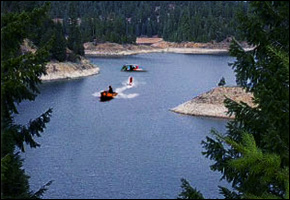Colorado Developer Provides Customer List for Proposed Water Pipeline
Demand is higher than the proposed supply for the 560-mile pipeline from Wyoming’s Flaming Gorge Reservoir to eastern Colorado.
 By Brett Walton
By Brett Walton
Circle of Blue
Colorado’s potential water demand from a proposed water pipeline originating in Wyoming is 50 percent more than the amount proposed for delivery, according to documents submitted yesterday to the U.S. Army Corps of Engineers.
Water entrepreneur Aaron Million wants to sell up to 250,000 acre-feet of water from Wyoming’s Green River – roughly the amount used annually by Denver. But total potential demand from interested parties is 379,100 acre-feet, according to requests from Million’s customer list. Meanwhile the Bureau of Reclamation has said that only 165,000 acre-feet is available in order to maintain adequate stream flows for fish.
Million could not be reached for comment by the time this article was published.
Interested parties–including irrigation districts, municipal suppliers, ranchers and private companies–have not committed to any contract. They have expressed desire to acquire a certain amount of water from the project, depending on price and demand. Total cost for the project is $3 billion, but no estimates are available for the cost of the water it would deliver.
The Million Conservation Resource Group pipeline project would send water 560 miles across the Continental Divide: from the Flaming Gorge Reservoir in Wyoming to urban areas along the Front Range east of the Rockies. The pipeline, which would be laid on federally-owned land for highways and utilities, would end south of Denver, in Pueblo, Colorado.
The water is part of Colorado’s unused allocation of the Colorado River under the Colorado River Compact, Million argues according to the Army Corps, which is overseeing the environmental impact assessment. Wyoming does not dispute the fact that Colorado has a legal right to the water, according to the Salt Lake Tribune.

The list of customers was required to show that the project is based on need and not speculation about future use. “We need to know the users of the water and how much they will be demanding,” Rena Brand, project manager for the Army Corps, told Circle of Blue in early January.
“Based on the information Mr. Million provides, the Corp will determine whether to proceed with the environmental impact statement,” Brand said.
The Army Corps declined to comment on the customer list while it is being reviewed.
Meanwhile, Colorado officials are taking a hands-off approach.
“Water is a private right in Colorado, so the state cannot propose specific concepts. A developer needs to come along to put forward those ideas,” Theo Stein of the Colorado Water Conservation Board told Circle of Blue.
Million’s pipeline is one of two proposals for developing the water in the Flaming Gorge Reservoir. The Colorado/Wyoming Coalition, led by Frank Jaeger of the Parker Water and Sanitation District, is a group of municipal suppliers also looking to deliver water to users in both states.
The Army Corps will hold meetings through late 2010 to gauge stakeholder opinion. A draft environmental impact statement will be available in 2012 and a final report is tentatively scheduled to be released in 2014.
For a more detailed description of the potential environmental effects see the Salt Lake Tribune
Note: the project timeline has been corrected from an earlier version of this article.
Brett writes about agriculture, energy, infrastructure, and the politics and economics of water in the United States. He also writes the Federal Water Tap, Circle of Blue’s weekly digest of U.S. government water news. He is the winner of two Society of Environmental Journalists reporting awards, one of the top honors in American environmental journalism: first place for explanatory reporting for a series on septic system pollution in the United States(2016) and third place for beat reporting in a small market (2014). He received the Sierra Club’s Distinguished Service Award in 2018. Brett lives in Seattle, where he hikes the mountains and bakes pies. Contact Brett Walton











There’s errors in this article. The Corps already held public meetings in 2009. Public input will not be received again until the Draft Environmental Impact Statement is out – maybe in 2012. A final EIS is estimated to be out in 2014.
Colorado’s potential water demand from a proposed water pipeline originating in Wyoming is 50 percent more than the amount proposed for delivery…..!
Really?May I ask if as of this date, there had been a meeting between concerned agencies and people? I think they should be, by now.
The Army Corps of Engineers held a series of public meetings in the first half of 2009 in Colorado, Wyoming and Utah.